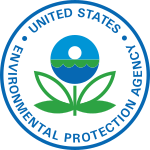
Back وكالة حماية البيئة الأمريكية Arabic Американска агенция за опазване на околната среда Bulgarian Agència de Protecció Ambiental dels Estats Units Catalan Agentura pro ochranu životního prostředí Czech Environmental Protection Agency Danish Environmental Protection Agency German Agencia de Protección Ambiental de Estados Unidos Spanish Ameerika Ühendriikide Keskkonnakaitseagentuur Estonian آژانس حفاظت محیط زیست ایالات متحده آمریکا Persian Yhdysvaltain ympäristönsuojeluvirasto Finnish
 Seal | |
Logo | |
 Flag | |
| Agency overview | |
|---|---|
| Formed | December 2, 1970 |
| Jurisdiction | United States federal government |
| Headquarters | William Jefferson Clinton Federal Building Washington, D.C., U.S. 38°53′38″N 77°01′44″W / 38.8939°N 77.0289°W |
| Employees | 14,581[1] |
| Annual budget | $9,559,485,000[1] |
| Agency executives |
|
| Website | epa.gov |
The Environmental Protection Agency (EPA) is an independent agency of the United States government tasked with environmental protection matters.[2] President Richard Nixon proposed the establishment of EPA on July 9, 1970; it began operation on December 2, 1970, after Nixon signed an executive order.[3] The order establishing the EPA was ratified by committee hearings in the House and Senate.
The agency is led by its administrator, who is appointed by the president and approved by the Senate.[3] The current administrator is Michael S. Regan. The EPA is not a Cabinet department, but the administrator is normally given cabinet rank. The EPA has its headquarters in Washington, D.C. There are regional offices for each of the agency's ten regions, as well as 27 laboratories around the country.[4]
The agency conducts environmental assessment, research, and education. It has the responsibility of maintaining and enforcing national standards under a variety of environmental laws, in consultation with state, tribal, and local governments. EPA enforcement powers include fines, sanctions, and other measures.
It delegates some permitting, monitoring, and enforcement responsibility to U.S. states and the federally recognized tribes. The agency also works with industries and all levels of government in a wide variety of voluntary pollution prevention programs and energy conservation efforts.
The agency's budgeted employee level in 2023 is 16,204.1 full-time equivalent (FTE).[5] More than half of EPA's employees are engineers, scientists, and environmental protection specialists; other employees include legal, public affairs, financial, and information technologists.
- ^ a b "EPA's Budget and Spending". Washington, D.C.: U.S. Environmental Protection Agency (EPA). May 16, 2022. Archived from the original on January 13, 2017. Retrieved January 12, 2017.
- ^ "Our Mission and What We Do". EPA. January 21, 2017. Archived from the original on March 28, 2017. Retrieved March 28, 2017.
- ^ a b "Reorganization Plan No. 3 of 1970". EPA. Archived from the original on February 12, 2018. Retrieved July 21, 2020.
- ^ "EPA Regional Laboratories Unique Analytical Capabilities and Services by Region". EPA. September 12, 2017. Archived from the original on April 4, 2018. Retrieved April 3, 2018.
- ^ "FY 2023 EPA Budget in Brief" (PDF). EPA. March 1, 2022. Archived (PDF) from the original on December 29, 2022. Retrieved January 11, 2023.